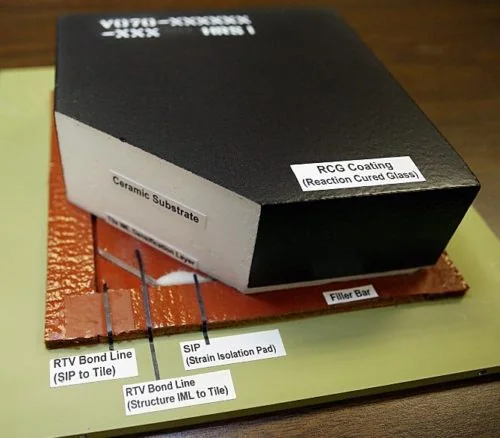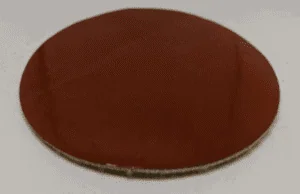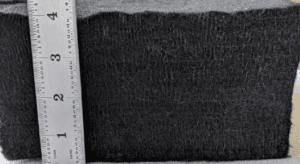The term thermal protection system (TPS) refers to various materials applied externally to the outer structural skin on an orbiter to maintain acceptable temperatures, especially for the reentry phase of a mission. Materials used for a TPS are selected for their high-temperature stability and weight efficiency.
Space vehicles that enter the earth’s atmosphere require thermal protection systems to protect them from aerodynamic heating. The TPS system used by space vehicles inhibits the conduction of heat on the interior of the vehicle by combining an underlying layer of thermal insulation with high-temperature resistant surface materials.
Thermal Protection System Materials
Friction with the atmosphere during re-entry produces extreme temperatures that require specialized shielding systems to protect space vehicles. In addition to heat, space vehicle thermal protection systems also shield systems and the airframe from the extremely cold conditions that occur during parts of orbit. A TPS is produced using the following materials:
Reinforced Carbon Carbon (RCC)
RCC is a strong all-carbon composite. It is light gray and able to withstand the aerodynamic forces of launch and re-entry, which reach up to 800 lbs per sq. ft.
Felt Reusable Surface Insulation (FRSI)
Felt Reusable Surface Insulation (FRSI) is a type of protective blanket material that shields orbiter surfaces from high temperatures. It protects surfaces from heat between 350 °F to 700 °F.
Reusable Surface Insulation Tiles
Space vehicle tiles come in two types: white for low-temperature applications, and black for high temperatures. High-temperature reusable surface insulation tiles utilize a black borosilicate glass coating that has an emittance value higher than 0.8. They protect areas of the vehicle which reach temperatures up to 2,300 °F.
Low-temperature reusable insulation tiles are coated in a white substance that contains the necessary optical properties to maintain on-orbit temperatures. These low-temperature reusable insulation tiles are placed on vehicle areas that have the potential to reach a maximum of 1,200 °F.
 Tile Bonding
Tile Bonding
The bonding agent that attaches tiles to the vehicle surface is a type of silicone adhesive. Silicones are an ideal bonding agent for these types of applications. They retain excellent bond strength during the high temperatures of re-entry and are also flexible at the low temperatures experienced during orbit.
Legacy TPS Products
Legacy materials are often difficult to source due to low volumes, and lack of demand for years, or even decades. Tex Tech is the only US company that has re-created these types of products to NASA specs to provide exceedingly well characterized materials that orbital vehicle designers can utilize with confidence.
Infused Stabilized Ablative Insulation Felt
Our system replaces a traditional single use cork TPS with a higher performance multi-use composite system that relies on a fiber reinforcing structure to increase the erosion resistance. Tex Tech produces low temperature ablative systems using felts that have been stabilized with a high char yield silicone. This silicone can also be customized further to meet low out-gas requirements when needed.
Multi-layered Felt Hybrids (MLF)

Requirements of a Thermal Protection System

- Heat load. Regulating the flow of heat into and out of the vehicle is the main role of thermal protection systems. In most situations, a TPS is designed around the aerodynamic heating during a vehicle’s re-entry into the Earth’s atmosphere. The TPS system must be able to withstand high temperatures without excessive degradation of material properties.
- Mechanic loads. Extreme aerodynamic pressure, as well as in-plane inertial, dynamic, and acoustic loads, are all mechanical loads on the TPS. The TPS must withstand these loads without failure.
- Deflection limits. The TPS shapes the vehicle’s aerodynamic profile. Surface deflections of the TPS need to be below a certain limit to maintain this aerodynamic profile and prevent local overheating and system failure.
- Impact loads. The TPS can be subjected to many types of impact during installation, launch, flight, and landing. Having adequate impact resistance is an important requirement of a TPS.
- Chemical deterioration. High surface temperatures during re-entry make the TPS susceptible to oxidation. It may also be altered during maintenance.
- Low-cost operability. A TPS will require maintenance throughout its life, in addition to the initial fabrication and installation costs. A TPS should be easily replaceable or repairable as well as designed to withstand a certain amount of damage without requiring immediate repair.
- Lightweight. Due to the large amount of space that a TPS occupies, it makes up a majority of the launch weight. To prevent the need for increased fuel requirements, a TPS must be as lightweight as possible.
TPS Solutions from Tex Tech
Tex Tech Industries is proud to be an industry leader in high-performance textile manufacturing. Since 1904, we have been delivering the highest quality products available for the most challenging applications. Our expert research and development team and state-of-the-art facilities allow us to provide the high-performance textile solutions the aerospace industry demands. For more information about our advanced TPS solutions or our other textile products and services, please contact us or request a quote today.

 Tile Bonding
Tile Bonding